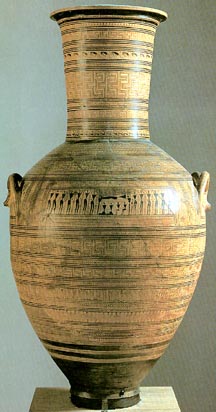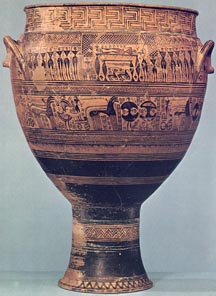These few basic linear and geometric motifs are repeated and combined in various ways over the surface of the vase. The pattern, which can form a rich tapestry of design covering the whole surface, usually maintains the integrity of the shape of the vase and reinforces emphasizes its parts.

Early Geometric Amphora
from the Kerameikos Cemetery, Athens
860-840 BCE
(Archaeological Museum of Kerameikos, Athens)
This Early Geometric amphora was used to hold the ashes and bones of the deceased. The geometric decoration is located in the areas of the lip, neck, shoulder, body (where the handles are), and foot.

Geometric Amphora
from Dipylon Cemetery, Athens
c. 750 BCE
Height 161/8 inches
(Museum Antiker Kleinkunst, Munich)
After about 800, animals begin to appear regularly in Geometric vase painting. Grazing deer under the lip or rim on the neck, crouching goats on the shoulder and long-necked birds on foot are repeated uniformly around this two-handled amphora.
Three rows or bands of fret or Greek key design, with a hatched interior pattern, appear on the neck and two more on the body. Other repeated motifs are diamond shapes (or linked zig-zag lines) with dots in the middle, a checker-board pattern, and triangles with diagonally hatched interiors.

Geometric Amphora
from Dipylon Cemetery, Athens
c. 750 BCE
Height 5 feet 1 inch
(National Archaeological Museum, Athens)
Human figures soon appear on the body in the zone of the handles. By the middle of the eighth century a style for human figures had evolved, though lines of animal lines still form part of the decoration.

Geometric Krater
from Dipylon Cemetery, Athens
c. 750 BCE
Height 4 feet
(Metropolitan Museum, New York)

DETAIL
Groups of figures also appear on gigantic vases intended for use as grave markers. Called Dipylon vases, they are named after a part of the Kerameikos Cemetery in Athens where they were first found. They are often very large.
|

 SPRING 2016
SPRING 2016  SCHEDULE
SCHEDULE  REQUIREMENTS
REQUIREMENTS

 SPRING 2016
SPRING 2016  SCHEDULE
SCHEDULE  REQUIREMENTS
REQUIREMENTS